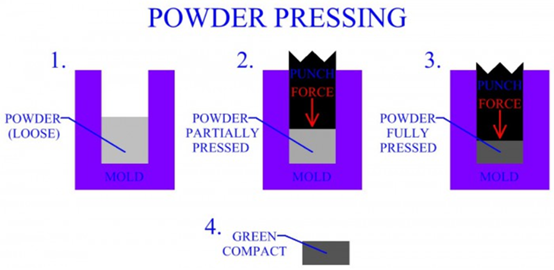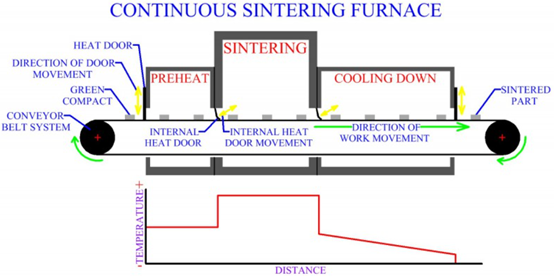Compaction and sintering is the process of forming powder into solid parts by first pressing and then sintering. In addition to the powder, adhesives, antiflocculants and lubricants are added to the mixture. Powder pressing is best suited for flat parts with two-dimensional geometry and low thickness. The problem with increasing part complexity and thickness is that the uneven compaction of the powder particles leads to large changes in density, and the defects caused by the need for spray compaction are compacted.
Powder compaction is the process of pressing the powder into a geometric shape, usually at ambient temperature. This produces a compact green. The strength of this compacted unfired component depends on the compactness, which can be increased by the use of glue. The green body can be disassembled with bare hands, but it is also strong enough. The geometric shape is similar to the final part, but shrinkage will occur at the sintering stage of the manufacturing process and must be calculated.
The powder requirement is based on the bulk density of the powder and the amount of material in the final product. The bulk density is the density of the loose powder itself. When measuring the quantity of powder, the bulk density is very important and the influence of additives such as lubricants should be calculated. For example, if a green body contains a certain amount of lubricant and binder, additional materials will be added. In the sintering process, these lubricants and binders are burned off and no longer exist in the parts, which is a factor that must be considered.
When a certain amount of powder is injected into the mould, the mould filling rate depends mainly on the flowability of the powder. Easily flowing powders can be injected at a higher rate and the injection process can be automated.
Once the mould is filled, the plunger moves towards the powder and the plunger exerts pressure on the powder to compact it into the correct geometric shape. The moulding process is shown in the figure.

Punch and die surfaces are very important in powder manufacturing. There must be a gap between the punch and die to allow the punch to move in the die. Powder particles can get stuck in the gap and cause problems with machine movement. To avoid this problem, the gap should be very small, usually less than 0.001 inch. Most punches and dies are made from hardened tool steel and their surfaces are ground and polished in the direction of tool travel. Punches and dies for more extreme powder processing are made from tungsten carbide.
The force required to press depends largely on the material. For example, pressing aluminum powder requires a low force, whereas iron powder requires a high force. The pressing force also depends on the powder properties, additives and the expected density of the green. During the pressing process, friction hinders the movement of the particles and the lubricant can reduce the pressing force required, making the particle distribution more uniform. Excess lubricant will collect in the space between the particles and organize the compaction of the powder. The pressing force is a function of the pressure on the part surface perpendicular to the pressing direction. Generally, the press is vertical and the horizontal plane of the part should be considered.
The force used in industrial powder manufacturing typically varies between 10000 pounds per square inch (70MPa) and 120000 pounds per square foot (800MPa). Most of these parts are small (less than 5 pounds) and the pressure requirement is generally less than 100 tons. A press with a capacity of a few tons is usually suitable for most powder work, while a hydraulic press with a capacity of several thousand tons is used for work requiring greater force. For more complex parts, the multi-action press can be used and the press speed must be adjusted. Faster compaction speed can improve production efficiency, but if the speed is too high, air will remain in the gap, preventing the parts from being properly compacted.
The characteristics of metal powder, including chemical composition, particle size distribution, particle shape and size and technical characteristics, have a significant impact on the compaction, sintering process, strength before sintering and the performance of the final product.
Chemical composition
The chemical composition of a powder usually refers to the content of major metals or components, impurities and gases. The content of main metals in metal powder is not less than 98% - 99%, which can completely meet the requirements of sintered parts. However, when manufacturing high-performance powder metallurgy materials, it is necessary to use powder with higher purity. The most common inclusion in metal powder is oxide. Oxides deteriorate the compressibility of metal powder and increase the wear of the die. Sometimes, a small amount of reducible metal oxide is beneficial to the sintering of metal powder. Because of the large specific surface area and small volume of metal powder, a large amount of gas is adsorbed on the surface of metal powder particles. There will be a lot of gas dissolved in the process of metal powder preparation. The main gases contained in the metal powder are oxygen, hydrogen, carbon monoxide and nitrogen. These gases increase the brittleness of the metal powder and deteriorate the compressibility, especially the plasticity of some refractory metals and compounds (such as Ti, Zr, Cr, carbides, borides, silicides). During heating, the strong gas precipitation may affect the normal shrinkage of the compact during sintering. Therefore, vacuum degassing treatment is often required for some metal powders.
Particle shape and size
Particle shape and size particle shape are one of the factors that affect the technical characteristics of powder (such as loose density, fluidity, etc.). Generally, the powder particles are preferably spherical or granular. Particle size is usually expressed by particle size. The particle size of powder manufactured in industry is usually 0.1-500 μm,150 μ Coarse powder, 40-150 μm is defined as medium powder, 10-40 μm is defined as fine powder, 0.5-10 μm is extremely fine powder, 0.5 μ Those below m are called superfine powder. The size of powder particles is usually represented by the screen number, and the various screen numbers represent the number of mesh holes per 1 square inch of screen. The size of powder particles directly affects the performance of powder metallurgy products, especially for cemented carbide and ceramic materials, the finer the powder particles are, the better. However, it is difficult to produce fine powder and its economy is poor.
Particle size distribution
Particle size distribution refers to the relative content of different particle sizes, also called particle size composition. The wide range of powder particle size composition results in high density and good performance of the product, especially for the strength of the edges and corners of the product.
Technical characteristics
Bulk density: refers to the mass of free bulk powder per unit volume. It is determined by particle size, particle shape, particle size composition and pore size between particles. The size of the loose charge ratio affects the compaction and sintering performance, and is a very important parameter for the design of the compression die.
Fluidity: refers to the time required for 50g powder to fall freely in the powder flow meter to the end of flow. The shorter the time, the better the liquidity. The powder with good fluidity is conducive to rapid and continuous powder loading and uniform powder loading of complex parts.
Compressibility: including compressibility and formability. Compressibility determines the strength and density of compacts.
Powder matching
Powder mixing is to fully mix various metal powders and additives (such as lubricants, etc.) according to the product ingredient calculation and specific particle size distribution. This process is completed by a powder mixer.
The addition of additives is mainly to improve the forming technical characteristics of the mixed powder. If lubricant (such as zinc stearate, mass ratio 0.25% - 1%) is added, the fluidity of the mixed powder can be improved and the compressibility can be increased. After pressing and before sintering, the lubricant shall be removed by heating method (such as zinc stearate in 375-425oC hot air).
The characteristics of mixed powder are often expressed by mixing degree. The greater the mixing degree, the more uniform the mixing; It is also more conducive to the performance requirements of products. However, the powder mixing process must be careful. Too intense mixing will cause deformation hardening, mutual wear of particles, delamination, etc., so it must be carried out according to the forming technical requirements and specifications.
The compaction of powder is the main and basic process. There are many methods of pressing and molding, and the internal density distribution of products is different with different pressing methods.
Steel mold pressing
It refers to the method of forming the loose powder in the steel mold into a blank by using a mechanical press or hydraulic press at a certain specific pressure (usually 150-160MPa) at normal temperature. This forming technology is the most widely used.
Hot isostatic pressure
Isostatic pressure forming technology is to place the sample powder to be pressed in a high-pressure container, and pressurize the sample uniformly from all directions by using the incompressible property of liquid or gas medium and the property of uniform transmission of pressure. When the liquid medium is injected into the pressure container through a pressure pump, according to the principle of fluid mechanics, its pressure is constant and uniformly transmitted to all directions. At this time, the pressure on the powder in the high-pressure vessel is uniform and uniform in all directions.
Three-dimensional compaction
It combines the characteristics of one-dimension steel mould pressing and isostatic pressing. The density and strength of the compacts obtained by this method are higher than those obtained by other forming methods. However, it is applicable to parts with regular shape, such as cylindrical, square, rectangular, sleeve, etc.
Sintering is a process in which one or more solid powders are formed, heated to a certain temperature, and begin to shrink, forming a dense and hard sintered body at a temperature below the melting point. This process is called sintering. The purpose of sintering is to transform the powder material into a compact body.
The main variables of powder sintering are time, temperature and furnace atmosphere. The sintering temperature is usually 0.7 to 0.9 of the powder melting point. The sintering time depends on the manufacturing process factors and materials. For example, the sintering time of tungsten is relatively long. Standard industrial powder sintering time for different processes and materials varies from 8 minutes to 10 hours.
In the process of powder sintering, the controlled atmosphere is very important. The purpose of atmosphere in sintering process is to control carburization and decarburization, prevent oxidation and remove existing oxides, prevent unnecessary chemical reactions, and assist in burning additives. Common atmospheres used for industrial powder processing are carbon monoxide, dissociated ammonia, hydrogen, partially burned natural gas and inert gases, such as argon or helium. Sometimes parts are also sintered in vacuum. Vacuum sintering is mainly applicable to refractory metals and stainless steel.
The sintering of raw meal pressing is carried out in three stages. First of all, the powder tablet should be preheated. Preheating will raise the component to a relatively low temperature and make the additive burn off. Preheating will also begin to strengthen the integration within the components and increase their integrity for the next stage. In the second stage, the temperature is raised to the sintering temperature and kept for a certain time to reach the required binding amount. In the third stage, when the parts are allowed to cool down, the temperature will decrease. During the cooling process, keeping the workpiece in a controlled furnace atmosphere is essential to prevent unnecessary chemical reaction between the workpiece and the environment.
In industrial powder manufacturing, there are two types of furnaces, batch furnace and continuous furnace. In the batch furnace, a small number of parts are put into the furnace, undergo the whole sintering process, and then taken out. The continuous furnace provides flow production and has three areas for the three stages of the manufacturing process (preheating, sintering and cooling). A moving belt carries continuous parts supply through the furnace. Hot parts can be quickly opened and closed, allowing parts to pass while maintaining heat. The belt travels at an accurate speed so that the parts have an accurate time in each chamber. Stable products and high productivity make continuous furnace the most common choice for powder sintering. Although batch operation furnaces have low productivity and less use, they do provide more control over the atmosphere, thus improving the purity of parts. Vacuum atmosphere can only be provided by batch furnace.

Bonding stage
At the initial stage of sintering, the original contact point or surface between particles is transformed into crystal combination, that is, the sintering neck is formed through nucleation, crystal growth and other original migration processes. In this stage, the grains in the particles do not change, the particle shape also basically does not change, the whole sinter does not shrink, and the density increases slightly, but the strength and conductivity of the sinter are significantly increased due to the increase of the particle interface.
Sintering neck enlargement stage
A large number of atoms migrate to the grain interface, which enlarges the sintering neck, reduces the distance between particles, and forms a continuous pore network. As the grain grows, the pores move across the grain boundary, and where the grain boundary sweeps, the pores disappear in large numbers. Sinter shrinkage, density and strength increase are the main characteristics of this stage.
Closed pore shrinkage stage
After the sinter density reaches 90%, most of the pores are completely separated, the number of closed pores increases, and the pores tend to be spherical and continue to shrink. At this stage, the whole sinter can still contract slowly, but it is mainly achieved by the disappearance of small pores and the reduction of the number of pores. This stage can last for a long time, but there are still a small number of isolated pores that cannot be eliminated.
Sintered parts offer new opportunities for creative and cost-effective design. In many cases, the use of powder to produce structural parts has proven to be more competitive than other technologies when producing parts with complex geometric shapes.
The manufacturing process involves pressing followed by sintering. More than 40 million sintered parts are produced every day for a wide range of industrial applications.
Less is more in the production of sintered metal parts. Using fewer process steps, machining, materials and energy is the most cost effective solution.
Sintered parts can offer more than cost savings. You can use specific materials to produce parts for specific purposes that are not possible with other manufacturing technologies.
BRM offers a variety of iron-based powders to ensure the right solution for each part and process.

Contact: Alexander Sun
Phone: +86 19916725893
Tel: 0512-55128901
Email: [email protected]
Add: No.6 Huxiang Road, Kunshan development Zone, JiangsuShanghai Branch: No. 398 Guiyang Rd, Yangpu District, Shanghai, China